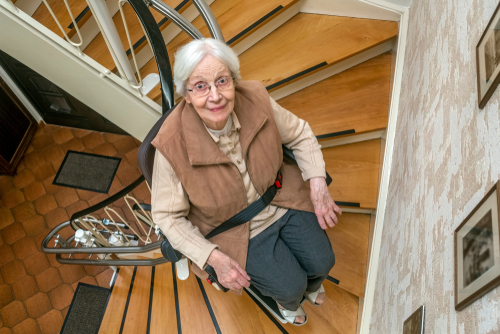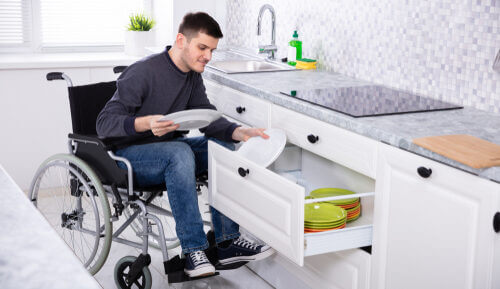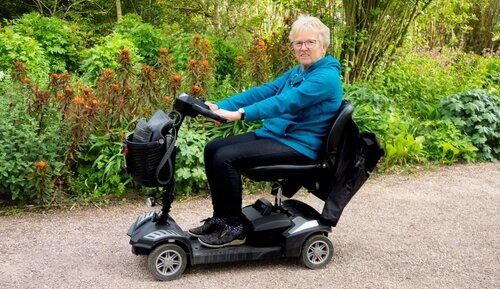Installing a stairlift can be a highly effective way to continue living in your home safely when climbing stairs becomes difficult. Costs vary widely depending on the type of staircase you have. Fortunately, there is significant financial help available, especially the Disabled Facilities Grant and other charitable funding routes.
The key is to plan ahead, get multiple quotes, assess your needs and home carefully, and ensure any installation is done professionally and maintained.

Page contents
Key points
What a stairlift does – Helps people with mobility issues move safely up and down stairs, supporting independence and avoiding the need to move home.
Typical costs – Straight stairlifts cost around £3,000–£3,500, curved models about £4,500+, and reconditioned ones £1,200–£2,500.
Financial help – Support is available through Disabled Facilities Grants (up to £36k depending on location) and charities such as Edward Gostling Foundation, Independence at Home, RABI, and SSAFA.
Installation and maintenance – A quick home survey determines the best model. Straight stairlifts fit in hours; curved ones take longer. Annual servicing is advised.
What is a stairlift and why should I consider one?
A stairlift is a mechanical device fitted to your staircase that allows a person with mobility issues to go up or down the stairs while seated (or standing, in some models).
You may have a disability or you may be 65+ and experiencing problems getting up and down the stairs.
Benefits include:
- They help you to continue living independently at home when climbing stairs becomes difficult.
- They can be safer than trying to climb the stairs unaided or with a walking aid.
- They may be more cost-effective than moving house or installing a full lift.
Stairlift prices: What you can expect to pay
Typical stairlift cost ranges
Stairlift costs will vary according to whether you are buying a lift for a straight staircase (with no bends) or if you are purchasing one for a curved staircase with landings, turns and bespoke rail.
- The average price of a straight stairlift is on average £3,371, according to a survey by Which?
- While the consumer organisation found curved stairlifts cost an average of £4,728.
- A cheaper option is a reconditioned stairlift which has been used before or refurbished. Depending on its condition, it can cost an average of £1,200-£2,500.
You can look for stairlift providers near you at Access BDD.
Costs of stairlift installation
If you need to reinforce the walls or the steps are very narrow, you may have to pay for extra work to be done.
If you’re eligible due to disability/chronic illness you may not have to pay VAT on the stairlift itself.
Can I get a grant for a stairlift?
If you are struggling to cover the cost of a stairlift, there are a number of schemes and reliefs that can help.
There are some government grants.
The main one is the Disabled Facilities Grant (DFG)
The Disabled Facilities Grant (DFG) is financial assistance available in England, Wales, and Northern Ireland to help people with disabilities or limited mobility make their homes more accessible. Around 50,000 people benefit from the grant each year.
How much can you receive?
- England: up to £30,000
- Wales: up to £36,000
- Northern Ireland: up to £25,000
(Scotland does not offer the DFG but instead provides similar support through the Scheme of Assistance.)
The exact amount awarded depends on household income and savings (over £6,000 may affect eligibility). Some councils may offer additional funding.
- Disabled children under 18 are automatically eligible — parents’ income is not considered.
- Landlords can apply for adaptations without their income being assessed, but if a tenant moves out within five years, the council may require the next tenant to be a disabled person.
Eligibility Criteria
To qualify:
- Someone in the household must be disabled or have limited mobility.
- The person must intend to live in the property for at least five years (unless special circumstances apply).
- The council must confirm the work is necessary, appropriate, and feasible for the property.
Once approved, work should be completed within 12 months, and should not begin until official approval is granted. You can read more about getting financial help with home adaptations in our article Home adaptations for older and disabled people.
How do you apply for a DFG?
You can apply for a DFG through your local council by clicking here. A decision must be provided to you by your council within six months of the application being submitted.
An occupational therapist will assess your needs and determine if a stairlift or other adaptations are necessary for your home.
Scheme of Assistance – Scotland
Unlike the rest of the UK, Scotland does not offer the Disabled Facilities Grant (DFG). Instead, local authorities provide support through the Scheme of Assistance, which helps residents adapt their homes to meet the needs of disabled occupants. Around 6,000 people benefit from this scheme each year.
How much funding is available?
The Scheme of Assistance provides financial support through grants or loans to adapt private housing for disabled residents.
- Grants cover at least 80% of the eligible costs.
- You may receive 100% funding if you receive one of the following benefits:
- Income-based Jobseeker’s Allowance
- Income-related Employment and Support Allowance
- Income Support
- Guarantee Credit element of Pension Credit
- Universal Credit
Local authorities may also choose to increase grant funding above 80% in exceptional circumstances, as outlined in their individual Scheme of Assistance statements.
Eligibility Criteria
Scottish local authorities must provide help in the following cases:
- When a property requires adaptations to make it suitable for a disabled person to live in — particularly when changes enable access to standard facilities.
- To reinstate a property that has previously been adapted.
- When a work or statutory order has been served on a property owner.
All assistance must comply with equality laws, meaning no applicant can be discriminated against based on disability, gender reassignment, pregnancy or maternity, age, race, religion or belief, sex, or sexual orientation.
How to apply
Applications for the Scheme of Assistance can be made through your local authority. Forms are usually available online via council websites or in person at local housing offices. Guidance and support are also available from the Citizens Advice Bureau.
What charities give financial help with stairlifts?
There are a number of charities that can also give financial assistance towards stairlifts.
Two which may be able to give you financial assistance with purchasing a stairlift are The Edward Gostling Foundation and Margaret’s Fund.
Others include:
Independence At Home
They help people with a long-term illness or disability with financial help towards the cost of specialist equipment or home adaptations.
Independence at Home only accepts grant applications from health or social care professionals, or advisors and support workers from other organisations or charities.
RABI Independent Living Grants
Specific stairlift grants may also be available to you depending on the type of industry you have worked in.
The Royal Agricultural Benevolent Institution (RABI) Independent Living Grants is available to farming families. These can be used to help people to make their house or flat more accessible.
RABI states on its website that it awards an estimated £3 million of direct financial support annually.
RABI Independent Living Grants are available to support low-income farming families in the UK, as well as possibly those in the farming industry when there is a financial crisis.
SSAFA Help With Mobility
The Soldiers’, Sailors’, and Airmen’s Families Association (SSAFA) Help With Mobility for those who have served in the Armed Forces.
SSAFA Help With Mobility services are available to any individual who has received a minimum of one day’s pay from the British Army, Royal Air Force, Royal Navy or Royal Marines, which includes the Reserves. Immediate family of a person who has served for these Armed Forces are also eligible to receive these services.
If you want to find out more about the financial assistance available through RABI Independent Living Grants, contact the charity’s support team on 0800 188 4444 to start an application.
How does stairlift installation work?
Pre-installation steps
- Home survey: A stairlift company will visit your home, measure the staircase, assess width, obstacles, power supply, etc. They’ll determine whether your staircase is suitable and which model is required.
- Quote and choice: Based on the survey you’ll receive a quote outlining the device cost plus the installation as well as any extra works needed.
- Funding check: If you’re applying for a grant, wait for confirmation before you commit to any installation work.
- Planning & preparation: The installer may require you to ensure the area is clear, that power supply is accessible, and that any required remedial works (such as wall repair) are done in advance.
The installation process
- For a straight stairlift, installation often takes only a few hours (2-4 hours is typical) in standard circumstances.
- For a curved stairlift, the rail will be bespoke-manufactured to fit the exact shape of your staircase. This can add days or weeks to the lead time.
- The installer will secure the rail onto the staircase (not usually drilling into load-bearing walls) and then mount the seat/drive unit. They’ll test the operation, safety features, battery backup (most models have battery power so they still work in a power outage) and ensure it’s safe.
- After installation you’ll be shown how to use it, how to fold the seat/rail (many models fold up to keep the stairs usable for others), how to call/park it, and what maintenance is required.
- You should receive documentation: usage instructions, warranty, service schedule.
After installation and maintenance
Consider future needs: If mobility might decline further, you might choose a model with higher weight capacity or additional safety features.
Regular servicing is advisable (often annual) to ensure safety, especially as wear and tear occurs.
If you ever move home, many stairlift companies will offer the option to uninstall and re-install in the new property or recondition it.
Ensure you understand warranty terms: what parts are covered, what the requirements are.

